A Porsche and a Pontiac meet to mull the fate of empires
Our man Stefan Lombard stammered a bit when asked how he came up with the idea—which we have gone to enormous lengths to execute—of gathering a 1973 Pontiac Trans Am SD-455 and a 1973 Porsche 911 Carrera RS 2.7 in the central Texas Hill Country. “They are kind of the same shape,” he began. “Well, they both have ducktails. The Firebird was the pinnacle of Pontiac production, the 911 was the pinnacle of… you know… Porsche.” He’s on a roll now, hand on chin, eyes at the ceiling. “They have enough small similarities that added up in my mind to—it was just kind of a ‘what-if’—plus, it’s Porsche’s 75th anniversary, and there will be a lot of stories, but not this one.”
At least that last part is certain.
You can classify cars a lot of different ways—by make, by body type, by price, by size, by national origin. Here are two cars joined pretty much solely by year. And the fact that they are both coupes. And they both have four seats (the Porsche is debatable on that point). And they both lean on the sporty side. OK, that’s an understatement; the Porsche was as close to a street-legal factory racer as you could buy in 1973, and even crazier cars were ahead in the company’s future, which is what helps make the ’73 RS so ridiculously valuable today. More on that in a minute.

The Pontiac, meanwhile, is also pretty special, practically a factory hot rod championed and steered through GM’s red-tape forest by a dedicated group of engineers. It is one of just 252 Super Dutys built in 1973 and one of just 73 with a four-speed. Plus it was the final act, practically the end of the road for the division’s decade-long craze for shoving its largest engines into its smallest cars. In 1973, the optional $521 Code X engine, the Super Duty 455, had an 8.4:1 compression ratio and was rated at 310 horsepower. Two years later, the Code X was gone, the Code Y 455 offering a pale 200 horsepower via a 7.6:1 compression ratio. By 1978, the big 455 was extinct.
What the ’64 GTO wrought, the ’73 Firebird Trans Am SD-455 effectively finished, as Pontiac’s performance cars thereafter lost their punch to emissions regulations and oil embargoes. Pontiac as a division still had a few good years left in the ’80s and ’90s, but in between, the so-called widetrack Tigers were tamed and shackled into toothless kittens.
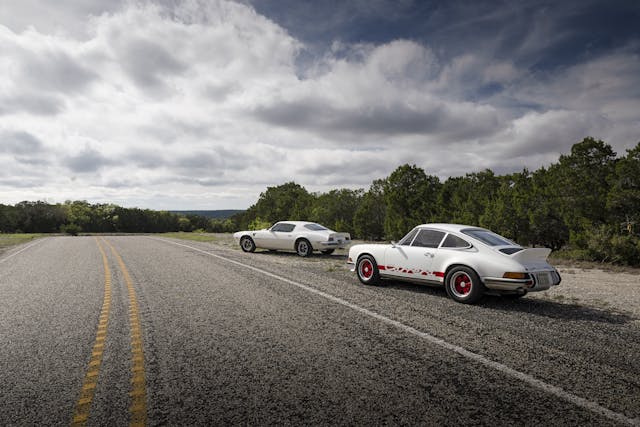
Thus, one empire, Porsche, rising; one empire, Pontiac, in decline. Ever has it been so. The Egyptians gave way to the Greeks who gave way to the Romans, all of whom left behind a lot of stuff we would classify as condition #4 or worse. As Pontiac began its long glide toward eventual mothballing in 2010, Porsche ascended to heights in sales and profitability that would have been unimaginable to founder Ferdinand Porsche (as would the modern SUVs that largely did the heavy lifting).
And the troubled year of 1973—sample newspaper headlines: “Nixon Claims History Will Justify Viet War;” “Inflation Our Big Problem Now;” “Cold Weather Could Intensify Energy Crisis;” and “Stories on Watergate, Syphilis Top Journalism Award Winners”—seems as likely a year as any to be considered the crossover point. Hence, this matchup. You’re welcome, Stefan.

On a gloomy Tuesday in March with a blanketing overcast sky bringing forth wind and spurts of rain, we rolled out of Kerrville, Texas, a town about two hours west of the state capital in Austin. The Mooney Aircraft Company once built small planes here with their famously distinctive forward-swept tails. The Porsche and the Pontiac both have rearward-swept tails, plastered with 3-inch-high lettering shouting their names at the traffic. Because you could do that back in the 1970s, pizazz up your most macho models with bright paint and colorful graphics. You could even paste a flaming blue bird on the nose and everyone up to and including the Marlboro Man thought it was cool.
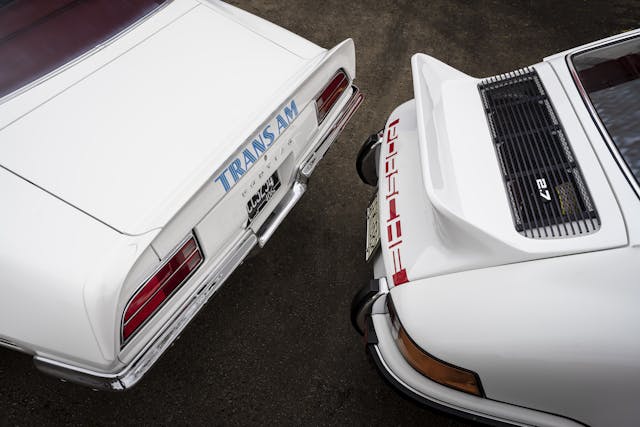
But then, GM was pretty fearless back in those days. Unlike today’s glacially slow ooze of design evolution, the second-gen Camaro/Firebird, delayed until early 1970 after slowdowns caused by a strike, was a clean break from its predecessor. Pontiac’s then-design chief, Bill Porter, and his team channeled European themes by leaning and visually lowering the car while stripping off most of the chrome and traditional Detroit gimcrackery. The new polyurethane front bumpers supplied by Detroit’s McCord Corp. and its Davidson Rubber Division—GM called it the “Endura” bumper when it debuted on the ’68 GTO—had looked somewhat grafted on when it was applied to the ’69 Firebirds. Now, for 1970, the stylists were able to shape a whole new front end around the bumper, crafting a long and low sportster with alluring proportions behind twin flaring nostrils that defined a clean and all-business nose.
Our Trans Am owner, Keith Sasich of Dallas, certainly likes the look. A lifelong drag racer who started in Pontiacs and still owns his first car, a ’67 Firebird 400 that he laid his eager teenage mitts on in 1974, Sasich walked away from a chance to buy a ’73 Super Duty in 1979. The car was $3500, and the mistake haunted him down through the decades. Just a few years ago, he put up his paddle at Barrett-Jackson for the numbers-matching example you see here, adding it to an all-American collection that tilts toward Pontiac and includes a ’69 GTO Ram Air Judge four-speed and a ’71 455 H.O. Judge. “Many a true Pontiac fan wants these cars,” he says of the Super Duty, conceding he probably paid too much (funny, our Porsche owner said the same thing), but hey, what the hell. He really wanted that four-speed, even more than his preferred color of Brewster Green.
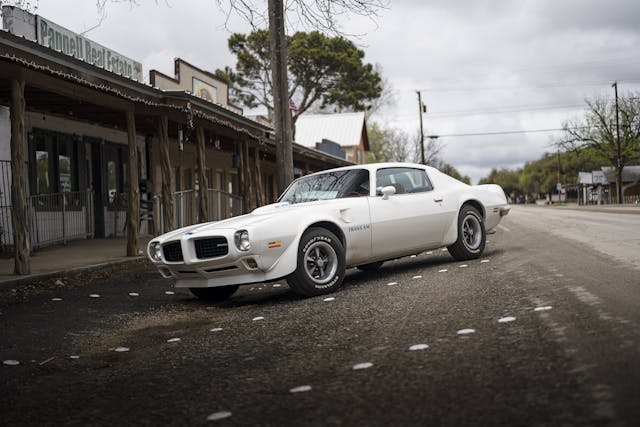

There’s nothing subtle about the Firebird, which is all thundery bravado when you pry open the single 800-cfm Rochester Quadrajet to let the 455 (technically, it’s a 456) inhale. The retro remanufactured Goodyear Steelgards fitted to this car can’t maintain grip against the tidal wave of torque any better than the originals did back in the day, and the ’Bird shakes its tail feathers reliably and hilariously at the slightest provocation. Much finesse must have been required for magazine testers to pull out a 13.7-second quarter-mile in period. Hands up, those who think drag racing isn’t hard.
Buick, Oldsmobile, and Pontiac offered 455s in 1973, but because this was old GM, before bean counting all but eliminated the independence of the divisions, the three engines were completely different except for displacement. The cast-iron Super Duty outwardly resembled the Pontiac 455 available in other Firebirds, but Special Projects engineer Herb Adams along with Skip McCully and Tom Nell labored to make the oily innards feature improvements gleaned from NASCAR, NHRA, and Trans-Am racing, all while still meeting new emissions limits. They include thicker internal block bracing, four-bolt main bearing caps for greater crankshaft support, connecting rods and pistons that were forged for more strength, and an 80-psi oil pump for better lubrication at higher revs.
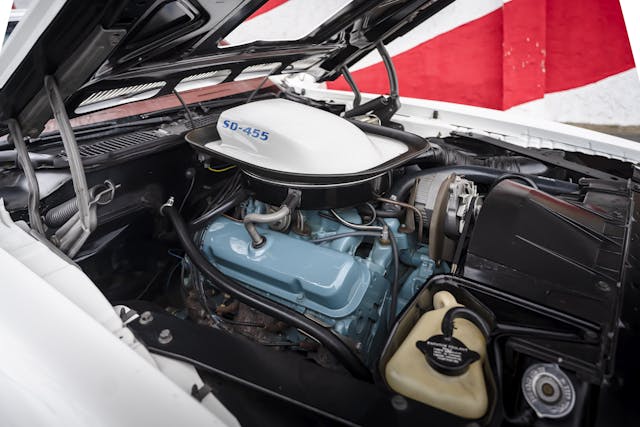
GM’s suits had by this time banned multi-carb induction setups like the famous GTO Tri-Power, so the Super Duty ran the single, lunchbox-size Rochester four-barrel under a Shaker scoop poking through the hood. The twin forward-facing ducts of the lesser Firebird Formula’s hood were said to be better for breathing, but the Shaker, as always, puts on a better show.
GM automatics in this era had developed to a reliable state of creaminess, which helps explain why so few of the Super Dutys were built with a stick in ’73. There’s no particular joy in shifting the Muncie M20 four-speed with its Hurst shifter about as long as a Texas copperhead. Unless, like Sasich, you were raised on them. Mile-long and trucklike throws along with a heavy clutch are what you remember most, as well as the amusing fact that—per some GM lawyer most likely—you can’t pull out the ignition key unless the shifter is moved to reverse. As you do it, you can hear the cables and pulleys of this Rube Goldberg safety interlock sliding and spooling behind the dash, all part of the charm of this rare car.
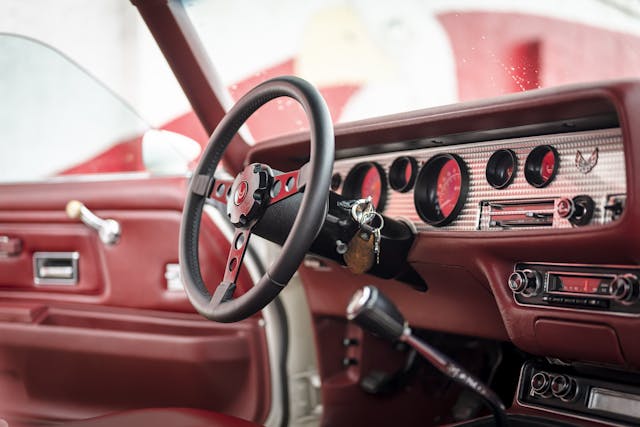
Everything feels bigger in the Pontiac, especially the expansive dash trim that salesmen claimed at the time was easier to remove thanks to it being mounted with a total of five screws. Lightbulb swaps in the new F bodies were said to take a mere 60 seconds. In contrast, the delicately spoked and leather-wrapped steering wheel seems small for a car weighing close to 2 tons, a lot of it engine. Our relatively gossamer Porsche was fitted with a plastic rim at least an inch larger. But alas, there is power steering, something the Porsche doesn’t have—or need.
That’s because the Carrera’s creators in 1972 targeted a weight for their RS homologation special of slightly under 2000 pounds. As has so often been the case with Porsche, what the company said it was going to do, it did with aplomb. The result is a glorious little corner eater you drive with your fingertips and toes, the center-mounted tach—where else?—effortlessly zinging on a crescendo of air-cooled clamor to its 7200-rpm redline.
The Carrera feels just as small and light as it looks sitting next to the Pontiac, with that classic upright seating position putting you in perfect relation to the pedals and five-speed shifter. If you bemoan the acres of plain, hard plastic in the Trans Am, you won’t find much relief in the spartan Porsche, even though its price new was more than twice that of the Pontiac. This Porsche isn’t a car as much as it is a tool, and to murder a phrase about a hammer, when all you have is a Carrera, all your problems look like racetracks.
Especially the narrow scribbles that interconnect Texas Hill Country burgs such as Barksdale and Leakey by cutting through the hillsides of limestone and clay, providing undulating, constant-radius joy for drivers and cyclists equally. Having at one time or another owned 35 Ferraris and too many Porsches to remember them all, our Carrera’s custodian, Mike Green of Houston, isn’t easily impressed, but he does like these roads and knows them well.
A longtime exec with the Sysco food distribution giant, Green was out buying hot stuff when it was just lukewarm. But he got bit by the Carrera bug too late and, as mentioned earlier, “paid too much. But I wanted to make sure I got a good, genuine car. I like my cars to be factory spec; taking the original seats out [they’ve been substituted with more comfortable chairs] is kind of a big deal for me.”
Porsche by 1973 was no longer the cottage German firm that seemed to uneducated eyes to make nothing more than hyper Volkswagens. It had only a few years earlier taken its first 24 Hours of Le Mans victory—not in class, but overall, with the outlandish 917K, which instantly elevated the Stuttgart stable above so many of its longtime British and Italian rivals (granted, Alfa Romeo won Le Mans in the 1930s, but that was already ancient history)
However, Porsche’s 240-mph, cost-no-object racing program couldn’t be sustained for long. Thus, when engineering leader Ernst Fuhrmann took over the top technical job in 1971, he was determined to refocus the company’s racing efforts back on production-based models and especially the 911, the better to remind buyers what Porsche mainly sold in its dealerships. As one door closed—1973 was the final year for the 917 in Can-Am—another door opened with a car that took its name from Porsche’s 904-through-908 racing Carreras of the 1960s as well as its long-ago campaigns in the famous Mexican road race, La Carrera Panamericana, which ran from 1950 to 1954.
Key to the effort was getting the 911 accepted for the newly revised FIA Group 4 “Special Grand Touring” competition class, which required that at least 500 units be built for sale to the public. A then-young engineer named Norbert Singer, not long out of the Technical University of Munich, was put in charge of developing the 911 Carrera RS. If Singer’s name is familiar even to non-Porschephiles, it’s because he went on to blaze an illustrious career in the ensuing decades as the company’s brilliant racing czar.
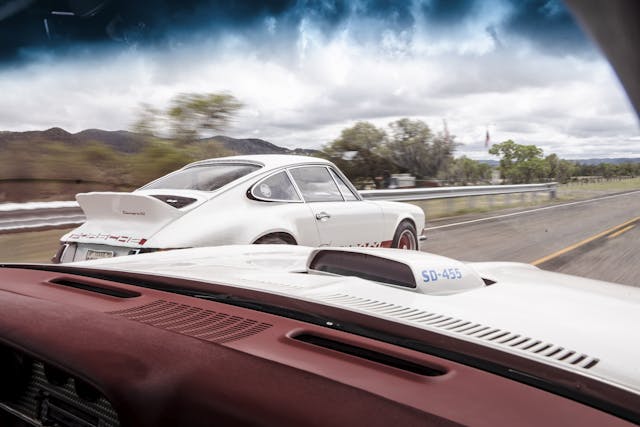
Aerodynamic enhancements like the famous fiberglass Bürzel, or ducktail, were shaped in Porsche’s new wind tunnel while Singer and his colleagues went to work on the chassis and engine, stripping the 911 of carpet and other sound insulation. Out went the bolstered door panels, replaced by simple flat panels with pull cords, as well as the sun visors, clock, under-coating, exterior trim, glovebox, even the gas struts holding up the front trunklid. Anything that could be yanked out without impeding the car’s performance was yanked, though some luxuries crept back in later in an optional Touring trim. The magic of the RS, however, is in the stuff you can’t see from the sidewalk; engineers spec’d thinner sheetmetal and glass for the RS to shave pounds, as well as lighter Bilstein shocks, the first Porsche production car to wear them and the beginning of a very long association between that brand and Porsche.
It’s not entirely wrong to say the 2.7-liter flat-six is half of a 917 flat-12. The Carrera’s 210-hp fuel-injected mill was bored out from the regular 911 S’s 2.4-liter to eventually share its bore and stroke measurements with the later 917/10 Can-Am car (and who didn’t have the Corgi model of that white wedge with its red and black L&M cigarette logos?). The Carrera’s engine employed a then-radical spray-on hardening process called Nikasil, developed by the German supplier Mahle for strengthening an aluminum engine’s otherwise fast-wearing cylinders.

So many important firsts, so many distinguished fingerprints; the 1973 Carrera RS ranks among the cream of the Porsche collector car elite. Though at the time, writes eminent Porsche chronologist Karl Ludvigsen, the company worried that all 500 units would not find buyers, especially since the 2.7-liter engine hadn’t been certified for U.S. sales. The price was thus kept artificially low, at the German deutsche mark equivalent of around $10,000. However, the initial run was sold out within a week of the Carrera’s debut at the Paris Salon in October 1972, and the company went on to produce three times as many as originally planned—1580—thus launching a dynasty.
Of course, that’s not nearly enough cars in a world of 8 billion people, so the Carrera RS, like the even rarer Super Duty, trades hands for many multiples of what lesser—but really, not that much lesser—versions go for. Here are two cars from the very unsentimental year of 1973 that prove that no matter what, in the collector car world, it’s all about sentiment. And personal choice informed by your own history, your own experiences, and your own tastes.

Mike Green and Keith Sasich both unquestionably fall under the title of “car guy,” but, as with their cars, they don’t have much in common beyond that. Sasich likes his thrills one quarter-mile at a time and doesn’t own a foreign collector car. And Green has never owned an American muscle machine—or, indeed, any American collector car beyond a modern Ford GT. We tried to persuade him, but no luck.
Different passions inflame in different directions, and 1973 was a crossroads year in which two storied brands found themselves on vastly divergent trajectories reflected in this pair of special, limited-production cars. The good news is that a half-century later, in times that are perhaps equally fraught and uncertain, you still have some excellent choices. Perhaps 50 years hence we’ll be publishing a comparison of the Porsche 911 GT3 RS and Dodge Challenger SRT Demon 170, both new for 2023. Stefan is already working on the pitch.
***

This article first appeared in Hagerty Drivers Club magazine. Click here to subscribe and join the club.
Check out the Hagerty Media homepage so you don’t miss a single story, or better yet, bookmark it. To get our best stories delivered right to your inbox, subscribe to our newsletters.

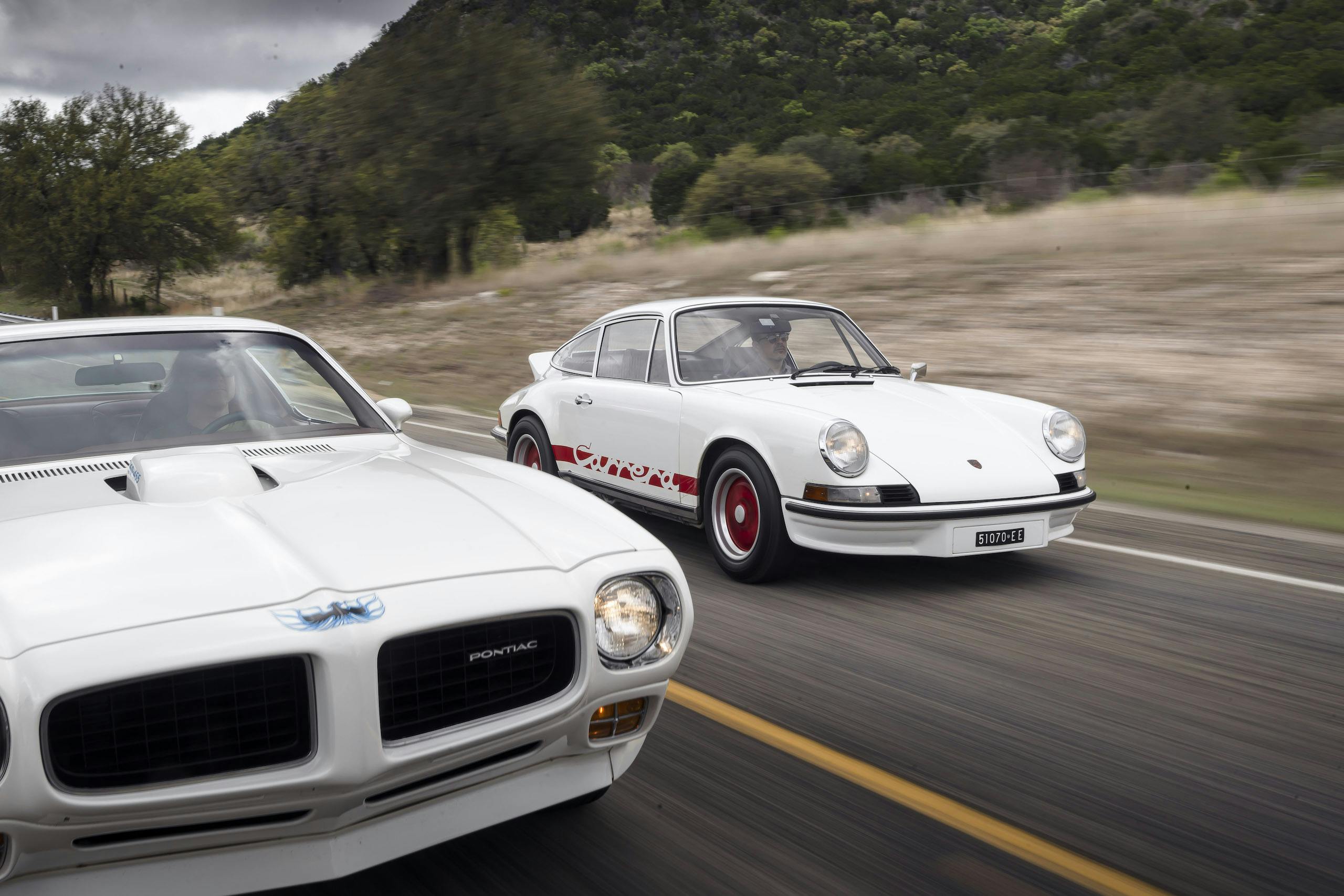

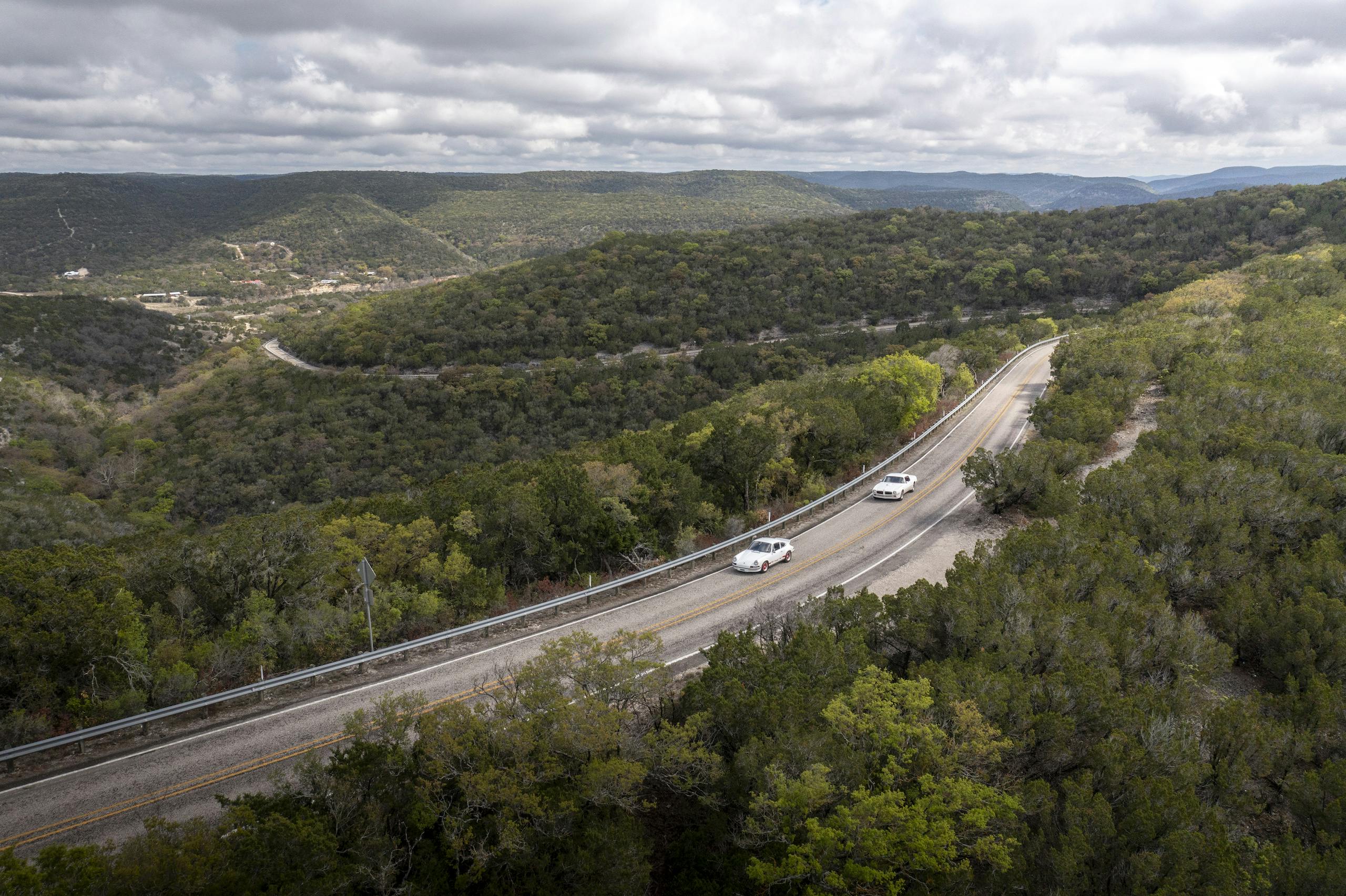
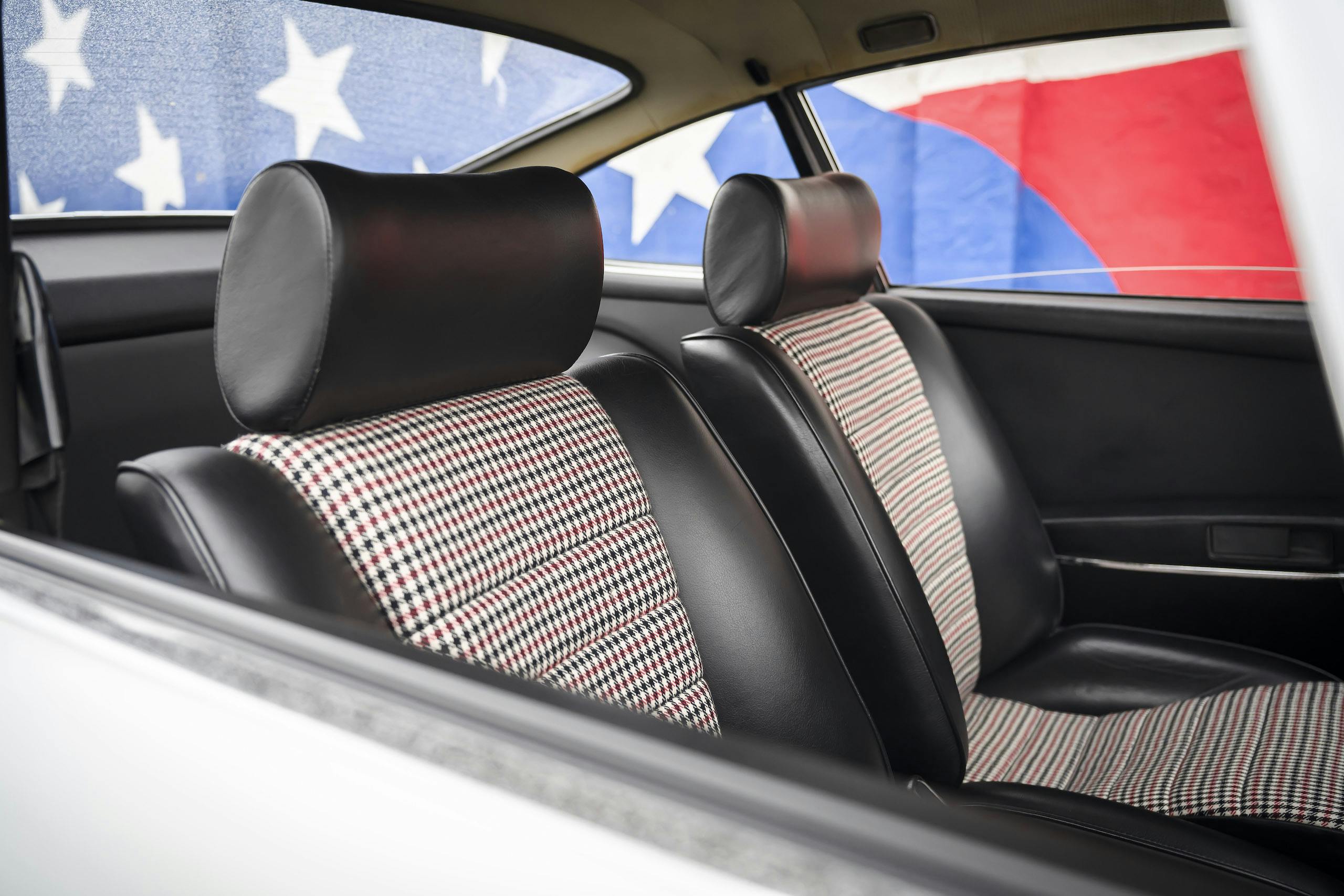
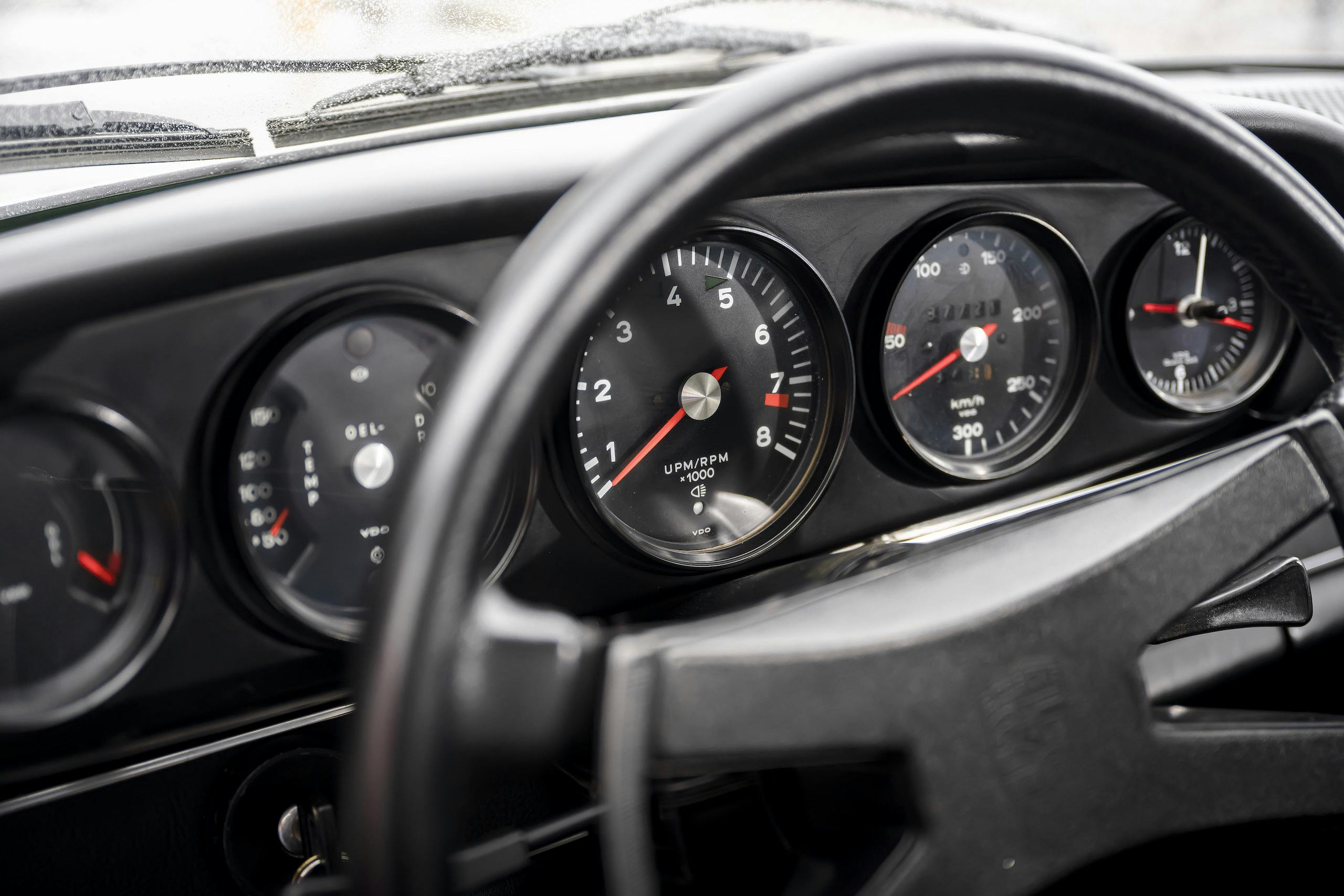


Nice overview of both cars. But any chance there’s a part II coming with more of a comparison and driving impressions? It’s an interesting matchup.
Yes, please!!!
These were performance tools of two different cultures. I recall a teacher in school that owned a Carrera. We felt bad for her as it was as we called it the cheap one that did not come with carpet. Hey Grade Schoolers were not up on light weight models. I bet today she wishes she still had it. She autocrossed it regularly.
As for Pontiac the death of Pontiac was this. Bunkie And Delorean were engineers and understood performance. GM as a whole never had a full grasp of what to do with Pontiac. Chevy also refused to give high ground in performance. This led to Pontiac breaking many rules and making many enemies at GM.
John did the GTO and broke rules along the way. By the time he went to Chevy to save the Vega he was a marked man. Herb Adams worked hard to keep Pontiac relevant and the 455 SD was proof it still could be done government regulations be damned. This engine was destined for the Grand Ma and other models rill GM Stopped it.
They had a smaller lighter V8 Adams was working on that could have supported Pontiac with Higher RPM and more power in a smaller package. It was killed so Adams walked away.
Pontiac as an engineers division. They got it and they were working 10 years ahead of Chevy. I just saw a 421 SD OHC V8 last week at the Pontiac nationals. Also there was a Hemi Pontiac there.
Pontiac was at its best them it broke rules and these engineers did that from 1960 till 1988. But GM took more and more away from Pontiac till it became an design exercise.
The Fiero was the last of the rule breaking as the same engineers that John brought in supported and hid the car away from GM to get it built. They suffered the lack of money but they did get it built at the cost of not getting all the car they wanted.
Imagine what GM could have done had they let Delorean do what he wanted in the 60’s with radial tires, OHC engines , Fuel Injection. 4 wheel disc brakes. electronic ignitions etc.
Porsche on the other hand was handled by a company that understood performance and what to do with it. VW also let them be Porsche and not tried to compete with them over the years.
Yes Porsche made mistakes. The 924 and other low cost models never really worked. The 928 was too much too soon,. But they got the focus on the 911 again and tried to not over produce them to where it killed the image of an exotic.
My fear is GM will hurt the Corvette by trying to cash grab by building a SUV. They hold the volume to not need to do one as Porsche as they are part of Chevy.
I wish they would name it a Nomad and say it was tuned by team Corvette. This way if it fails it can be recalled with less name equity damage.
That kind of bureaucratic interference compromises untold products to this day. I’ve worked at several companies where I’m confident we could’ve gotten more done, more efficiently if we paid the administration to stay home and locked them out of their emails.
The problem with any company is getting the right people in the right numbers in the right places.
Like it or not if a company was run only by engineers it would fail quickly and if it were ruled by accountants only then it also would die. The key is to have the right engineers and designers that will deliver the right product and the accountants to make sure it will make money, Bob Lutz himself said bean counters are not always bad and often save the engineers and designers from themselves.
I am a GM guy but will be the first to admit they really lost their way in the 60’s and later when they had too many plans and not one compete single vision for the company. Too often they were letting divisions complete vs making them compliment each other.
They also had the wrong people when they tried to make every car corporates when they really needed to cut some divisions. Times changed and the Sloan deal no longer worked. Buick and Old needed to go long ago. And to be honest Pontiac in todays market would not fair well as performance cars are falling away fast.
As for Pontiac vs Porsche. I was never a big Porsche guy but I have a lot of wheel time behind a 911 Carrera. It taught me how to go stupid fast and not have to work hard to do it.
The Trans Am on the other hand would go fast but you had to work for it. Not always a bad thing as it made you hone your skills more.
Both cars look great. I lean slightly more to the Pontiac in this case but will take both without any hesitation.
I’m fortunate to still have my first high performance car, a one-owner 1971 Camaro SS, as well as a 2021 Porsche 718 Spyder – 50 years separates my two favorite cars.
I actually owned both of these models (actually the T/A was a ’72 455 HO but the motor had been blueprinted by Balwin Motion so, equivalent). The T/A came from a Mercedes dealer as a trade-in and had all decals removed and a green vinyl top so sort of a sleeper. Owned it my last year of college (pay back from my Dad for getting a scholarship) and really loved it. Had to sell it as gas prices were going up and needed something economical (Toyota Corolla S-5) for graduate school. The RS came 16 years later when I was in Germany (Army). Drove it for 8 years and then sold it just before the meteoric price rise. Loved it also.
Thanks to you I got my first RS
The ’70-73 Pontiac looks good in all colours from Polar White to Lucerne Blue to Buccaneer Red and Brewster Green. Glad to see this one in Cameo White has a great care taker. Enjoy them and drive them.
As this droned on I kept hoping these cars would be driven at sine point. My bad.
Drove the Poncho. Great handling and super controlled. You could take big curves at speed with one hand dropped over the steering wheel and the other hanging out the window. Very stable and safe at speed. Owned the Porsche. The handling was something to keep a great grip on. BTW, the supposed evil rear engine handling was caused not by the engine location but by the super aggressive LSD which engaged and disengaged causing the car to snap spin or push. The brakes were subject to fade much sooner than that car deserved. But it is an icon for very good reason. Probably THE high point for Porsche. Owned a 87′ Turbo. Ok car but heavy and complicated.
Interesting comments about the ‘Bird’s shifter. I’ve not driven a ’70’s-era Firebird – nor 911 – but put many miles on an M-20/Hurst-equipped GTO and have spent time with an ’84 Carrera. Compared to the Carrera – and the numerous mid-engine cars I’ve owned over the years, the GTO’s shifting seemed telepathic with much shorter, more solid throws.
Don’t get me wrong; you definitely knew you were throwing around some planetoid-sized chunks of steel in the Goat’s box, but overall the action just felt that much more direct and instantaneous than cars with 4 or 5 feet of linkage separating shifter from gearbox.
That’s great stuff Woodrow, “plantetoid-sized chunks of steel in the Goat’s box”, ever consider writing about classics! I’m still chuckling……thanks.
After I stopped laughing (about 5 minutes) I started thinking about 911 tranny, and to note, my ’86 Turbo-Look’s 915 gear box isn’t the most fun thing to play with either. No chunks of steel, but you gotta pay attention……
Excellent story, thank you
Two really cool 70’s era iconic cars in really great colors. And really well written (LOL at times) with great insights to the way back machine and how things came to pass back in the old days. God, do I miss the 70’s…particularly the early years…..
I found this to be a very well written and well executed comparison and Stefan’s idea was very relevant. I know the focal point was to be Porsche’s 75 anniversary but felt both cars received equal billing. I’m the original owner of a 73 Firebird and my camp (owners of domestic muscle cars) didn’t have any love for the ‘VDubs’ of that era. Now that I’m older and wiser I can see the beauty of all (most) makes and models. I still love my Firebird who just turned 50 and believe the 70-73’s were the best looking of the second generation cars since what followed was the government’s five mile crash bumpers.
I reapectfully disagree with author’s opinion that either car was the pinnacle of their respective production. I am not as familiar with the Porsches of this era but the Pontiac was entering the malaise era. One year into the 1973 oil embargo, and Pontiac’s “best engine” was a gas guzzling rated between 175 hp and 225 hp. Hardly a pinnacle of achievement by any measure. I might add that Porsche was scrambling to meet the USAs looming safety and emissions requirements and was still a fairly small automaker by today’s standards. In either case, to call either of these products the “pinnacle” of their development is either incredible ignorance of the era or their respective products. Pontiac no longer exists but for either company, the best was still yet to come.
not sure what Pontiac “best engine” you have in mind but the 1973 SD 455 was rated 310 HP and probably put out considerably more than that. Even my all original brewster green 1973 TA 455 rated at 250 hp can push the car sideways on hard acceleration.
hate to pick nits, but What Enduro bumper on a 69 Firebird? Last time I checked, mine still had nice plating of chrome over its steel self. All they did in 69 was narrow the bumper so it didn’t surround the headlights as it did in 67 & 68
understand the Brewster Green color choice tho (and also passed up a chance to buy one when it was ‘cheap’) – is perhaps the best color car combo since the Veduro Green Birds of the 60s, or the Carousel Red of the 69 Judge